Introduction to Nanotechnology
Introduction to Nanotechnology. Alberto Quiñonez, Ph.D. Professor Electronics and Advanced Technologies Austin Community College. Visit for more Learning Resources. 1. Objective. The purpose of this module is to introduce the emerging nanotechnology field to novices of nanotechnology. 2.
Share Presentation
Embed Code
Link
Download Presentation

nancyd + Follow
Download Presentation
Introduction to Nanotechnology
An Image/Link below is provided (as is) to download presentation Download Policy: Content on the Website is provided to you AS IS for your information and personal use and may not be sold / licensed / shared on other websites without getting consent from its author. Content is provided to you AS IS for your information and personal use only. Download presentation by click this link. While downloading, if for some reason you are not able to download a presentation, the publisher may have deleted the file from their server. During download, if you can't get a presentation, the file might be deleted by the publisher.
Presentation Transcript
- Introduction to Nanotechnology Alberto Quiñonez, Ph.D. Professor Electronics and Advanced Technologies Austin Community College Visit for more Learning Resources 1
- Objective The purpose of this module is to introduce the emerging nanotechnology field to novices of nanotechnology. 2
- Topics • Nanotechnology Terms and Definitions • History of Nanotechnology • Current and Future Trends, Research and Applications 3
- Preface Is nanotechnology the gateway to the future for human beings on Earth? Figure 1.1: Where does your imagination take you? 4
- Emergence “…its arsenal includes nanotechnological transjectors…It can control other machines.” Figure 1.2: A nanocar made from a single molecule. Figure 1.3: Arnold Schwarzenegger’s character mentions nanotechnology in “The Terminator 3” movie. 5
- Nanotechnology Language Yow! • Nanobio • Nanodots • Nanowires • Nanoelectronics • Nanobots • Nanomaterials • Nanochondria Figure 1.4: Searching for nanotechnology. 6
- Definition “Nanotechnology is the understanding and control of matter at dimensions of roughly 1 to 100 nanometers, where unique phenomena enable novel applications.” “Encompassing nanoscale science, engineering and technology, nanotechnology involves imaging, measuring, modeling, and manipulating matter at this length scale.” National Nanotechnology Initiative, 2007 7
- Scale of Things—Nanometers Figure 1.5: National Nanotechnology Initiative. 8
- Internships Figure 1.6: Sematech nanoscholar interns of Texas. 9
- Brief History The concepts of nanotechnology are not new to nature or to mankind. An early example of a manmade nanoprocess is stained glass. Figure 1.7: Stained glass windows. Figure 1.8: Picture of gold nano particles. 10
- Brief History, Continued • Birth of Nanotechnology • Professor Taniguchi of Tokyo Science University used the word “nanotechnology” to describe the science and technology of processing or building parts with nanometric tolerances. • A nanometer is a unit of length in the metric system, equal to one billionth of a meter. Figure 1.9: Tokyo Science University. Figure 1.10: Equivalent Units 11
- Brief History, Continued • Dr. Richard P. Feynman • “Why cannot we write the entire 24 volumes of the Encyclopedia Britannica on the head of a pin?” • Dr. Richard Feynman, one of America’s most notable physicists, 1918-1988. Figure 1.11: Richard Feynman. 12
- Brief History Continued, • Dr. Feynman, Continued • “The problems of chemistry and biology can be greatly helped if our ability to see what we are doing, and to do things on an atomic level, is ultimately developed – a development which I think cannot be avoided.” Surely You’re Joking Mr. Feynman! Adventures of a Curious CharacterBy Richard Feynman Figure 1.12: Collection of reminiscences by Nobel Prize-winning physicist. 13
- Brief History, Continued • Atomic Scale • A computer image of the nano ice double helix. • In the nano ice image, oxygen atoms are blue in the inner helix, purple in the outer helix. Hydrogen atoms are white. Figure 1.13: A nanotechnology self-assembly process. 14
- More History • Eric Drexler • Coined the term “Grey Goo”…the potential problem of self-replicating and autonomous artificial intelligence machines. Engines of Creation The Coming Era of Nanotechnology By K. Eric Drexler Figure 1.14: Drexler’s book. Figure 1.15: DNA damage. 15
- X More History, Continued Eric Drexler, Continued Cell Repair Machines • “By working along molecule by molecule and structure by structure, repair machines will be able to repair whole cells. By working along cell by cell and tissue by tissue, they…will be able to repair whole organs…they will restore health.” - Drexler, 1986 Figure 1.16: Stylized example of targeted cell repair. 16
- More History, Continued • Metrology • Measurement of equipment is the cornerstone of nanotechnology. Figure 1.17: Scanning probe microscope systems from nanoscience instruments. Figure 1.18: Scanning tunneling microscope image. 17
- More History, Continued • Buckyballs • Three gentlemen—Harold Kroto from the University of Sussex, Robert Curl and Richard Smalley from Rice University—were awarded the Nobel Prize in Chemistry in 1996 for their discovery of a new composition of carbon, Carbon 60. Figure 1.19: Carbon-60 buckyball is shaped like a soccer ball. Figure 1.20: Example of Nobel prize diploma. 18
- More History, Continued • Fullerenes • Carbon 60 was named after Richard Buckminster Fuller, who went by the nickname “Bucky.” Figure 1.21: A “Buckyball.” Figure 1.22: Dome over biosphere in Montreal. 19
- More History, Continued • Top-Down Approach • Two approaches used in producing nanotechnology systems. Top-down method is used by computer chip manufacturers. Figure 1.23: Moore’s Law. Figure 1.24: Photolithography. 20
- More History, Continued • Bottom-Up Approach • Bottom-up approach to manufacturing is analogous to the way biological systems are made. Figure 1.25: An example of a molecular self assembly through hydrogen bonds. 21
- Summary Nanotechnology is ubiquitous and pervasive. It is an emerging field in all areas of science, engineering and technology. Welcome to NanoWorld! Figure 1.26: Robot image. 22
- References • American Ceramic Society (2006, March). Overview of Safety, Risks. American Ceramic Society Bulletin. Vol. 85 Issue 3, p6, 1/6 p. • Booker, Richard & Boysen, Earl (2005). Nanotechnology for Dummies. NJ: Wiley Publishing Inc. • Diott, D.D. (2006, April). Thinking big (and small) about energetic materials. Material Science and Technology. Vol. 22 Issue 4. p. 463, 11p. • Drexler, K. Eric (1986). Engines of Creation: The Coming Era of Nanotechnology. New York: Anchor Books. • Henderson, Donald (2006). Bioterrorism: Interview with Donald Henderson. Asia Pacific Biotech News. Vol. 10, Issue 1, p.18, 9p. • Intel (2007). Moore’s Law. Retrieved 7/02/2007 from http://www.intel.com/technology/mooreslaw/index.htm 23
- References, Continued • Lane, Neal & Kalil, Thomas (2005). The National Nanotechnology Initiative: Present at the creation. Issues in Science & Technology; Summer 2005. Vol 21, p49, 6p. • Lieberman, Marya (2007). Self-assembled monolayers and multilayers of phthalocyanines. University of Notre Dame: Department of Chemistry and Biochemistry. Retrieved 7/02/2007 from http://www.nd.edu/~mlieberm/ • Mandal, Deendayal; Bolander, Mark E.; Mukhopadhyay, Debrabrata; Sarkar, Gobinda; • Mukherjee, Priyabrata (2006, January). The use of Microorganisms for the formation of metal nanoparticles and their application. Applied Microbiology and Biotechnology. Vol. 69 Issue 5, p. 485, 8p. • Mostow, Jonathan (Director). (2003). Terminator 3: Rise Of The Machines [Motion Picture]. United States: Warner Bros. Pictures. 24
- References, Continued • Murday, James F. (2005). Nanotechnology: Hype and Hope in Aerospace Applications. Advanced Materials and Processes. Vol. 163, Issue 12, P. 21, 2p. • Nanotechnology at UT Austin (2007). Graduate Portfolio Program. Retrieved 6/27/2007 from http://www.cnm.utexas.edu/graduateportfolio.html • Nanotechnology Now (2006, March). Nanotechnology documentary to be filmed at nanoTX'06. Retrieved 7/02/2007 from http://www.nanotech-now.com/news.cgi?story_id=14281 • National Nanotechnology Initiative - NNI (2007). What is Nanotechnology? Retrieved 6/25/2007 from http://www.nano.gov/html/facts/whatIsNano.html • Rappaport, Tatiana Gabriela (2006). Semiconductors: Nanostructures and applications in spintronics and quantum computation. Vol. 809 issue 1, p.326, 17p. 25
- References, Continued • Ratner, Mark & Ratner, Daniel (2003). Nanotechnology: A Gentle Introduction to the Next Big Idea. New Jersey: Prentice Hall PTR. • Rouekes, M. L., Fritz, S., Stix, G., Whiteside, G.M., Love, J.C., Alivisatos, A.P. et al. (2002). Understanding Nanotechnology: Scientific American. New York: Warner Books. • Terra, Richard P. (2000, March). National Nanotechnology Initiative in FY2001 Budget: Clinton Administration Requests $497 million for NT-Related R&D Funding. Foresight Nanotech Institute. Retrieved 4/02/2007 from http://www.foresight.org/Updates/Update40/Update40.1.html • UNL News Releases (2006, December). Self-assembling nano-ice discovered at UNL; structure resembles DNA. Retrieved 6/28/2007 from http://ucommxsrv1.unl.edu/unlnews/public/fmpro?-db=unlnews.fp5&-format=newsrelease.shtml&-lay=unlnews&-recid=33994&-find= 26
- References, Continued • Wikipedia (2007). Moore’s Law. Retrieved 7/02/2007 from http://en.wikipedia.org/wiki/Moore%27s_law • Wikipedia (2007). Nature. Retrieved 7/05/2007 from http://en.wikipedia.org/wiki/Category:Nature • Wong, H.S. Philip (2006, March). Nanoelectronics – Opportunities and Challenges. International Journal of High Speed Electronics and Systems. Vol. 16, Issue 1, p. 83, 12p. • Yamaguchi, Tomohiko; Epstein, Irving; Shimomura, Masatsugu; & Kunitake, Toyoki (2005, December). Vol. 15, Issue 4, p. N, 3 p. • Zyvex: Nanotechnology Website: There’s Plenty of Room at the Bottom. Retrieved 6/27/2007 from http://www.zyvex.com/nanotech/feynman.html. For more detail contact us 27
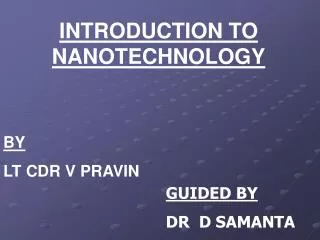
INTRODUCTION TO NANOTECHNOLOGY
INTRODUCTION TO NANOTECHNOLOGY. BY LT CDR V PRAVIN. GUIDED BY DR D SAMANTA. NANOTECHNOLOGY. THE REVOLUTION OF ENDLESS POSSIBILITIES. CONTENTS. INTRODUCTION NANOTECHNOLOGY BASICS SALIENT FEATURES WORKING PRINCIPLE APPROACH, CONCEPTS & STRUCTURE APPLICATIONS
979 views • 47 slides

Introduction to Nanotechnology
Course Overview. Goals and objectivesWeek by weekAssignmentsCourse website / ETUDES
322 views • 12 slides
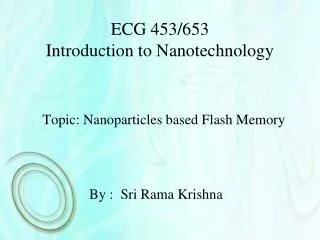
ECG 453/653 Introduction to Nanotechnology
ECG 453/653 Introduction to Nanotechnology. Topic: Nanoparticles based Flash Memory. By : Sri Rama Krishna . Over View :. Flash Memory Introduction, Types, Principle of operation, Applications. Nanoparticles Definition,
439 views • 17 slides

Introduction to Nanotechnology/ Nanoscience
Introduction to Nanotechnology/ Nanoscience. The 5 Ws. WHO. Majors in Chemistry Physics Biology Biotechnology Engineering & Technology. High School Students @ their high schools Students from other colleges during Summer School . WHAT.
383 views • 11 slides
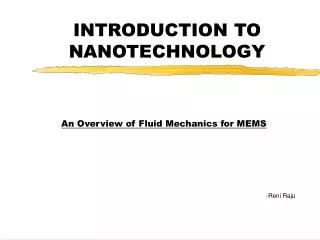
INTRODUCTION TO NANOTECHNOLOGY
INTRODUCTION TO NANOTECHNOLOGY. An Overview of Fluid Mechanics for MEMS -Reni Raju. MEMS (Applications). Accelerometers for airbags Micro heat exchangers Sensors Actuators Micropumps. NEMS (Application). Nanostructured Catalysts Drug Delivery systems Molecular Assembler/Replicators
488 views • 24 slides

Introduction to Nanotechnology
Introduction to Nanotechnology. Course Overview NANO51. Course Overview. Goals and objectives Week by week Assignments Course website / ETUDES ‘Hybrid’ venue Your instructor PNPA approach. Goals and Objectives. Learn what nanotechnology is all about Build out your ‘nano vocabulary’
295 views • 12 slides

Introduction to Nanotechnology
Introduction to Nanotechnology. Alberto Quiñonez, Ph.D. Professor Electronics and Advanced Technologies Austin Community College. 1. Objective. The purpose of this module is to introduce the emerging nanotechnology field to novices of nanotechnology. 2. Topics.
495 views • 27 slides
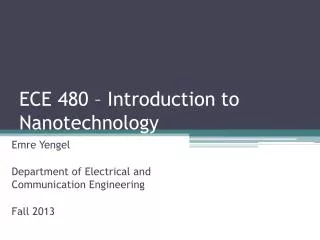
ECE 480 – Introduction to Nanotechnology
ECE 480 – Introduction to Nanotechnology. Emre Yengel Department of Electrical and Communication Engineering Fall 2013.
375 views • 19 slides

ECE 480 – Introduction to Nanotechnology
ECE 480 – Introduction to Nanotechnology. Emre Yengel Department of Electrical and Communication Engineering Fall 2013. Carbon; Basics. Carbon belongs to the group IV of the periodic table. It has four electrons in its outermost orbit, so its valency is four.
608 views • 47 slides

ECE 480 – Introduction to Nanotechnology
ECE 480 – Introduction to Nanotechnology. Emre Yengel Department of Electrical and Communication Engineering Fall 2013. Introduction and History. Magnification : objects are made to appear larger than they are Resolution : the ability to see close together objects as distinct
543 views • 40 slides
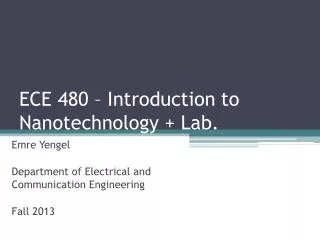
ECE 480 – Introduction to Nanotechnology + Lab.
ECE 480 – Introduction to Nanotechnology + Lab. Emre Yengel Department of Electrical and Communication Engineering Fall 2013. Goals of This Course. introduce the emerging nanotechnology field to novices of nanotechnology
555 views • 18 slides

Introduction to Nanotechnology
Introduction to Nanotechnology. Module 1 Definition and History of Nanotechnology. We’ve heard of……. Microscopes Microphones Microelectronics Microwaves Microbiology. They all have the same prefix……. “micro”. “Micro” comes from the Greek word that means “one millionth”
1.03k views • 26 slides
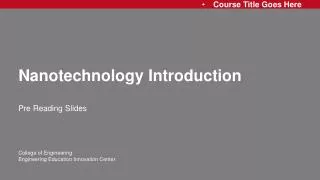
Nanotechnology Introduction
Nanotechnology Introduction. Pre Reading Slides. What is Nanotechnology?. Research and technology development at the atomic or molecular level, in the length scale of approximately 1 to 100 nanometer range (NNI Definition )
455 views • 17 slides

ECE 480 – Introduction to Nanotechnology
ECE 480 – Introduction to Nanotechnology. Emre Yengel Department of Electrical and Communication Engineering Fall 2013. Outline. What can we use a SEM for? How do we get an image? Electron beam-sample interactions Signals that can be used to characterize the microstructure
392 views • 29 slides

Introduction to Nanotechnology
Introduction to Nanotechnology. March 10, 2007. bnl. manchester. Introduction to Nanotechnology. Some things we will discuss:. March 10, 2007. How big are nanostructures Scaling down to the nanoscale How are nanostructures made? Fabrication, synthesis, manufacturing
848 views • 41 slides

Introduction to Nanotechnology
Introduction to Nanotechnology. Module 5 Forces and Interactions. What are some forces and interactions that influence material?. What are some forces and interactions that influence material?. Electrostatic Magnetic Gravitational Weak force (nuclear) Strong force (nuclear) Thermal
281 views • 7 slides

Introduction to Nanotechnology
Introduction to Nanotechnology. July 23, 2007. bnl. manchester. Introduction to Nanotechnology. Some things we will discuss:. July 23, 2007. How big are nanostructures Scaling down to the nanoscale How are nanostructures made? Fabrication, synthesis, manufacturing
862 views • 56 slides
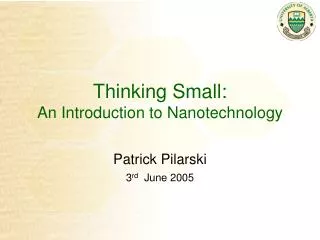
Thinking Small: An Introduction to Nanotechnology
Patrick Pilarski 3 rd June 2005. Thinking Small: An Introduction to Nanotechnology. Thinking about Shrinking. How tiny are these things? Getting small: Microtechnology Some Micro-motion examples How do we build and power them? Getting smaller: Nanotechnology The worlds smallest motors
357 views • 17 slides
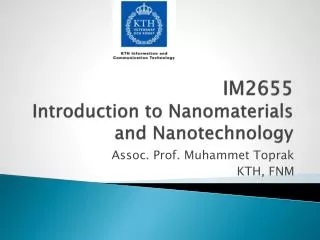
IM2655 Introduction to Nanomaterials and Nanotechnology
IM2655 Introduction to Nanomaterials and Nanotechnology. Assoc. Prof. Muhammet Toprak KTH, FNM. Level. D level course Compulsory for Nanotechnology Program Year 1 – Period 1 Grading scale: A-F Examination: Total 7.5p Participation (min 80%):
626 views • 13 slides

Introduction to Nanotechnology
Introduction to Nanotechnology. Mark Tuominen Professor of Physics UMass Amherst. Nanotechnology. What, How, Why?. Nanotechnology. The biggest science initiative since the Apollo program. Nanotechnology.
638 views • 29 slides
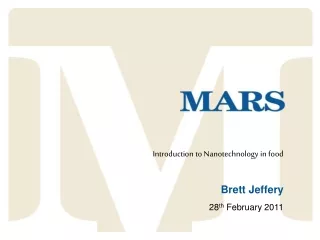
Introduction to Nanotechnology in food
Introduction to Nanotechnology in food. Brett Jeffery. 28 th February 2011. Introduction. Nanoparticles ‘are discrete entities that have one or more dimensions of the order of 100 nm or less’. 1000000nm. 10000nm. 150000nm. Introduction.
496 views • 20 slides























